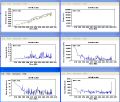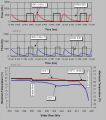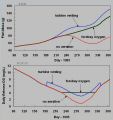|
|
1D River Model
Interfaces
|
RMS4
(pre-processor
for ADYN and RQUAL)

|
AGPM-1D
(post-processor
for ADYN/RQUAL)

|
Click
thumbnail to enlarge.
|
|
Email us
about 1D Tools
Order online |
|
A few AGPM customers
Modeling resources links
Overview
of River Modeling System (RMS4) Submodels:
|
Click
to enlarge following image
of
the River Modeling Systems
flow
chart.
|
By accessing or
using this web site, you accept these Terms
of Use |
|
 ADYN (Hydrodynamics)
ADYN (Hydrodynamics)
|
| Click
below to sample movie
|
| 
|
(.avi)
|
ADYN simulates discharge,
water surface elevation, and other hydraulic variables over time at numerous
model nodes throughout the simulated river system, based on a series of
irregular channel cross-sections and user specified channel roughness, boundary
conditions, and initial conditions.
Governing equations of conservation of mass and momentum are solved
using a 4-point implicit finite difference scheme with a generalized
Newton-Raphson iterative closure.
Hydraulic output available from ADYN results are numerous, but among
them are velocity, depth, wetted area, travel time, Lagrangian particle
tracking, wading safety index, stream power, etc. Boundary conditions are flexible, but hourly
dam discharges are typically used at the upstream boundary and an
elevation-discharge rating or elevation hydrograph is used downstream. Internal boundary conditions can be specified
for multiple weirs and dams along the modeled river and its tributaries. ADYN includes features for multiple dynamic
tributaries, junctions, and distributed or point lateral inflows. ADYN provides important hydrodynamic inputs
to RQUAL, RHAB, and FISH.
|
|
 RQUAL (Water Quality)
RQUAL (Water Quality)
|
| Click
below to sample movie
|
|

|
(.avi)
|
These
are some sample outputs of RQUAL
|
|
|
|

|
Click
to enlarge
|
RQUAL simulates
temperature, DO, and carbonaceous and nitogenous forms of BOD over time at
numerous model nodes throughout the simulated river system. User-specified temperature and water quality
for the main channel and tributaries serve as boundary conditions. The mass transport governing equation is
solved for each constituent using a choice of two numerical solution
schemes: 4-point implicit finite-difference or
Holly-Priessman characteristics scheme.
The model uses a full heat budget that includes atmospheric heat
exchange, channel shading by trees and barriers, channel bottom heat exchange,
heated discharges to the river, and other important factors. DO is influenced by turbulent and wind-driven
reaeration, weir aeration, photosynthesis-respiration of aquatic plants,
sediment oxygen demand, and oxygen demands in the water column from waste
loads, tributaries, and upstream sources.
RQUAL provides important temperature and water quality inputs to FISH.
|
|
 RHAB (Physical Habitat) RHAB (Physical Habitat)
|
|
|
RHAB simulates
weighted-usable area (WUA) based on suitability (SI) curves for individual fish
species and lifestages. A separate
model, CELVEL, uses ADYN discharges and produces a lateral distribution of cell
velocities for RHAB based on local roughness at ADYN model nodes (transects). Each cell has a specific wetted area,
velocity, and depth. These data are
combined with the suitability scores for each type of habitat, producing WUA
versus time at various sub-reaches along the modeled river. Thus, WUA versus dam discharge and other
investigations can be made with RHAB. As
an additional output, RHAB
also produces “high value WUA”, which includes only those cells with combined
suitability of 0.8 or higher (a user-defined threshold) on a scale from 0 to
1. High-value WUA provides an important
distinction from total WUA, because a single WUA magnitude can represent a
great amount of “marginal” habitat or a small amount of “high-value”
habitat. As an alternative to WUA, RHAB
can also quantify wetted areas sub-classed by depth.
|
|
 FISH (Bioenergetics
Fish Growth) FISH (Bioenergetics
Fish Growth)
|
| These
are some sample outputs of FISH
|
| 
|
Click
to enlarge
|
FISH simulates fish biomass over time at modeled river
locations resulting from bioenergetic exchanges during food consumption and
respiration processes. A team of TVA and
EPA-Corvallis researchers developed this model in the early 1990s specifically
for use hydropower tailwaters (Shiao, et. al. 1993). In FISH, growth responds to fluctuations in
temperature, DO, and food availability.
Temperature and DO are provided by RQUAL. Food availability is not simulated in FISH;
rather, it is back-calculated by calibrating the model to fish growth data from
tagged cohorts that are stocked and retrieved over time to measure growth.
|
|
Obtain technical support
here | Download publications
AGPM Users | Other modeling resource locations

|



















